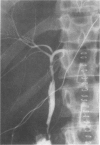Abstract
OBJECTIVE: The authors evaluate the safety, applicability, and effectiveness of a new technique for split-liver transplantation. SUMMARY BACKGROUND DATA: Split-liver transplantation offers an attractive way to increase the donor pool for cadaveric liver transplantation. The application of this concept has been hampered by inferior patient and graft survivals and higher complication rates. Without supportive data, the concern about increasing biliary leakage and poor initial graft function persisted. The authors focused on the causes of these complications by presenting a new technique to eliminate these problems. METHODS: Liver splitting was performed in the heart-beating cadaveric organ donor, using the technique described for procurement of the left lateral lobe of a live donor. A detailed description of the technique is presented. A retrospective review of the first 14 transplantations resulting from 7 in situ splitting procedures was collected. The results were compared with 19 conventional split-liver transplants performed during the same period. RESULTS: Six-month patient and graft survivals after in situ split-liver transplantation were 92.8% and 85.7%, respectively. Biliary complications were absent. Postoperative courses were mostly uneventful and characterized by lower peak transaminase levels compared with standard techniques. Early graft function of extrahepatic organs procured simultaneously was excellent. CONCLUSIONS: In situ split-liver transplantation provides superior results, related mainly to reduction of cold ischemic damage of the grafts and avoidance of biliary complications. In situ split-liver transplantation renders graft reduction alone obsolete and opens a donor pool for adults to receive right lobes safely. It allows for long-distance sharing between pediatric and adult liver transplant units because the procedure abolishes ex situ benching and prolonged ischemia time and provides two anatomically perfect grafts with hemostasis accomplished.
Full text
PDF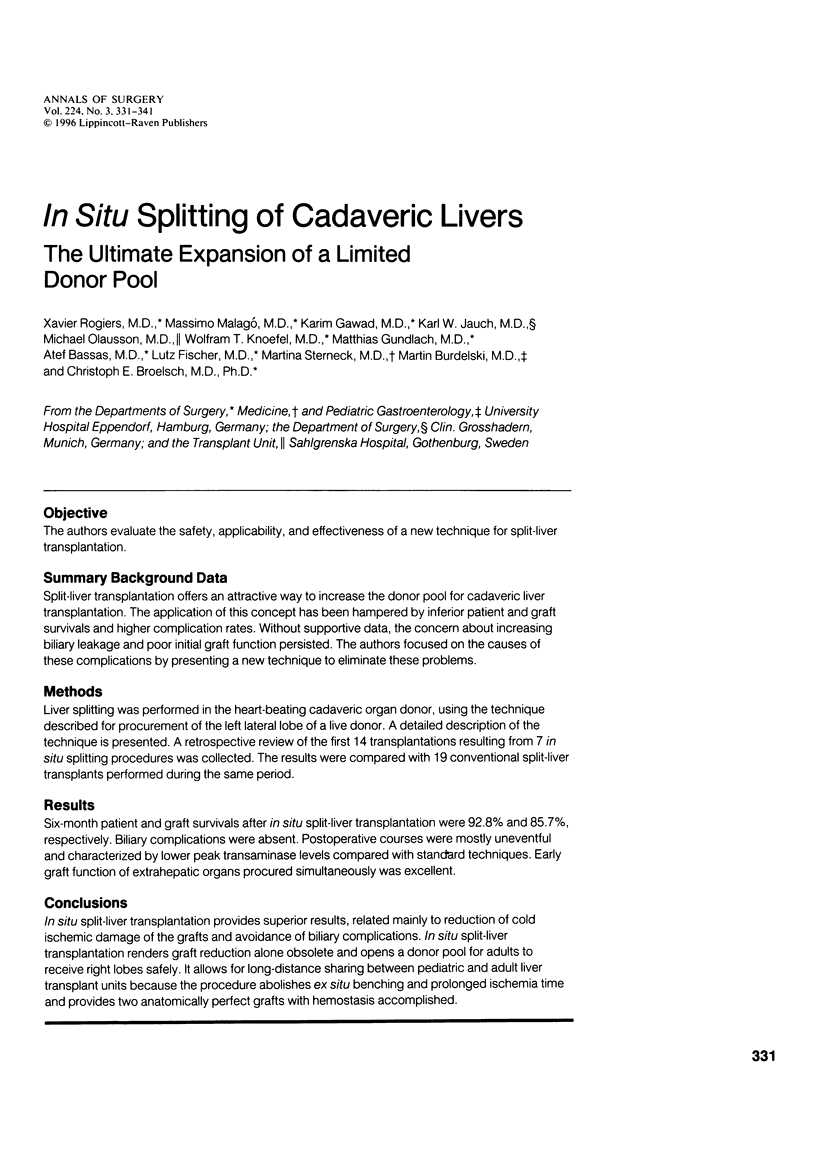
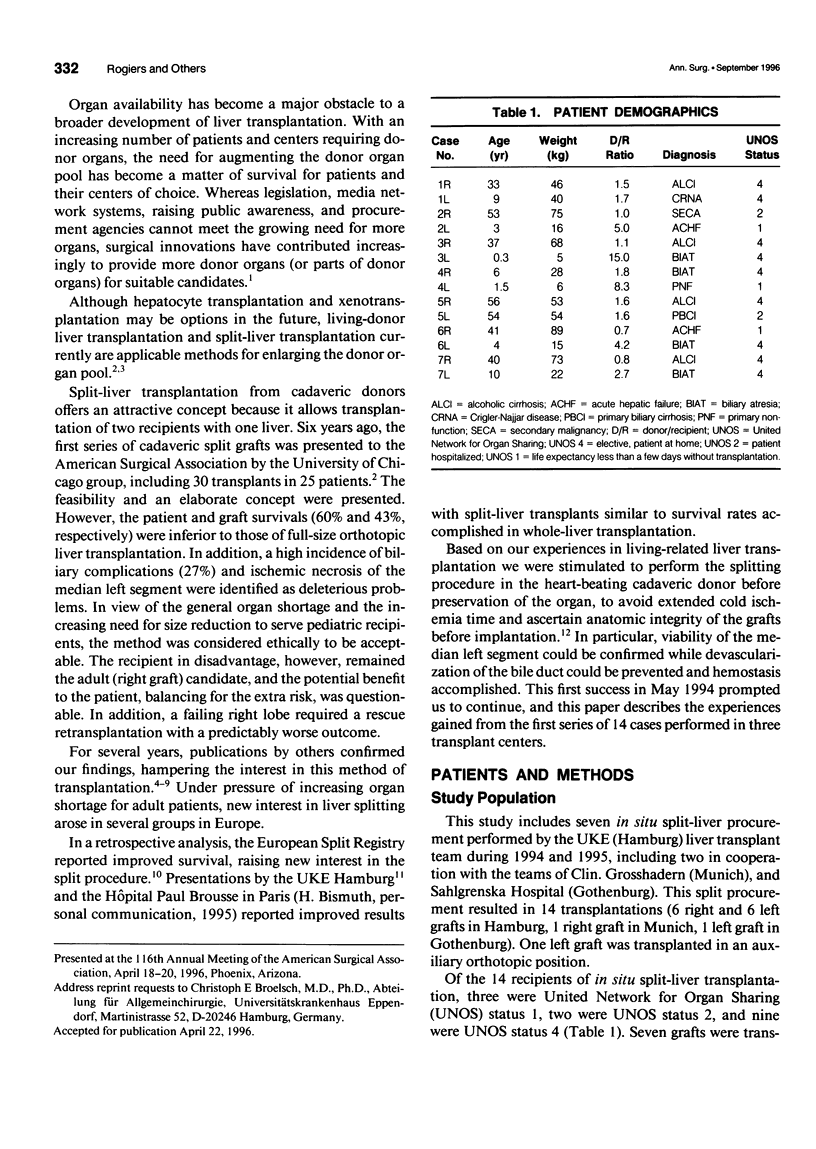
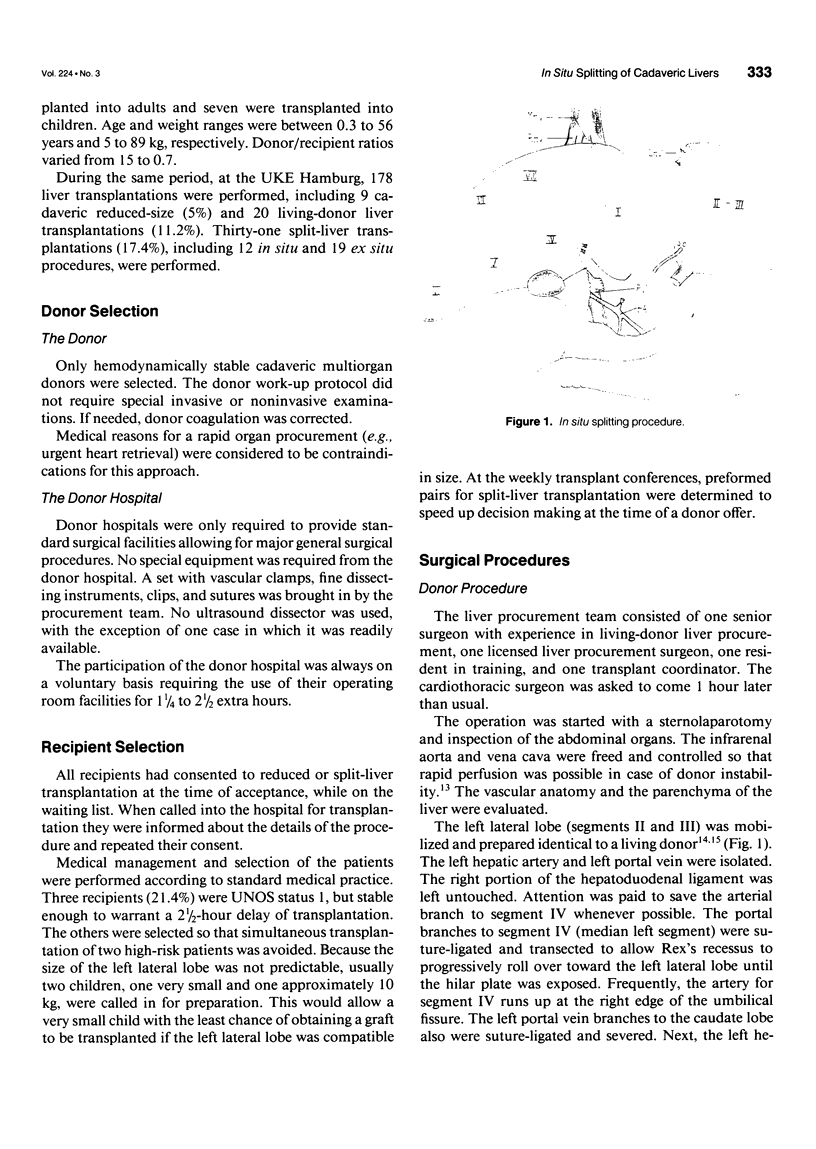
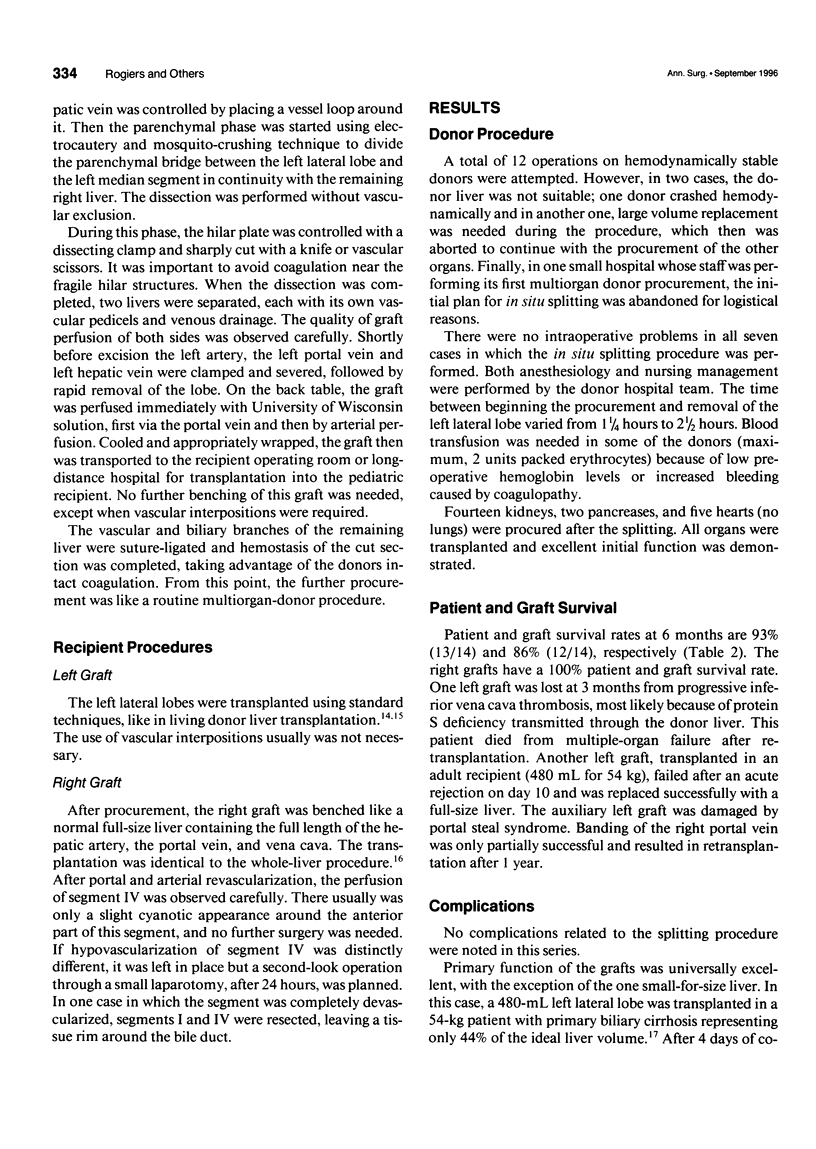
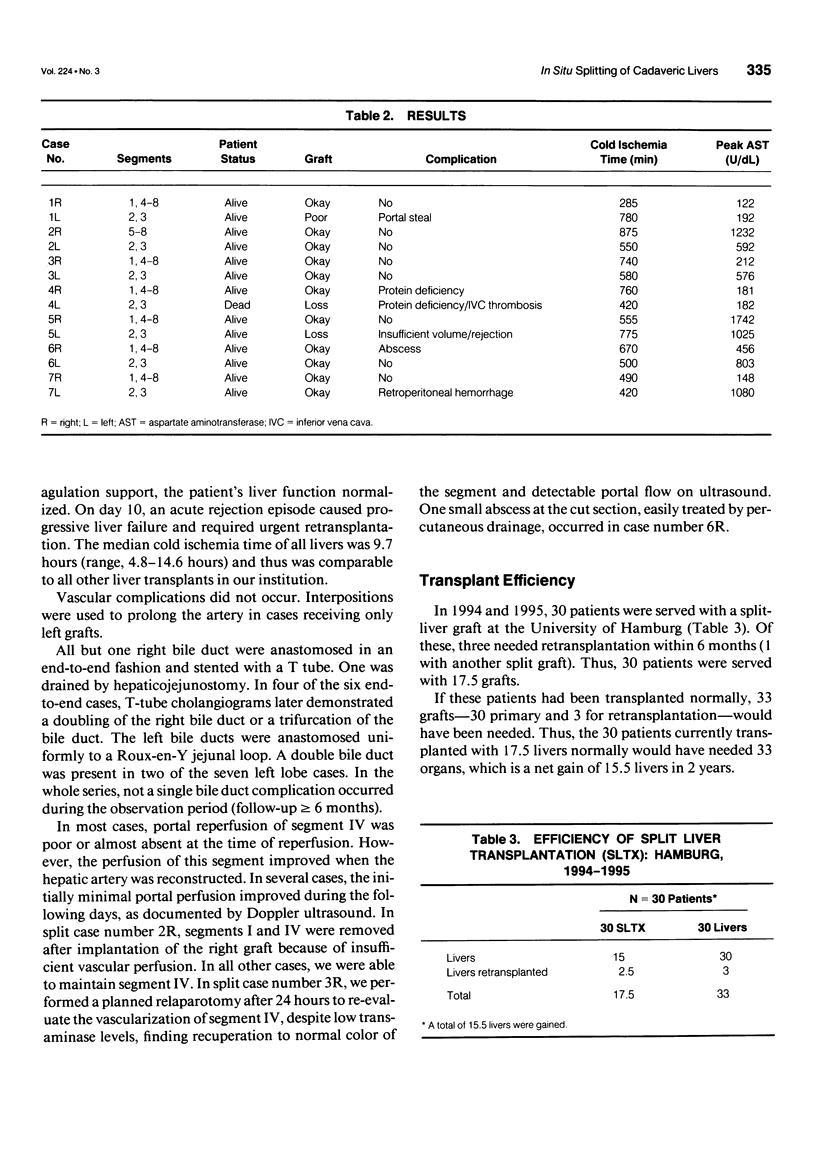
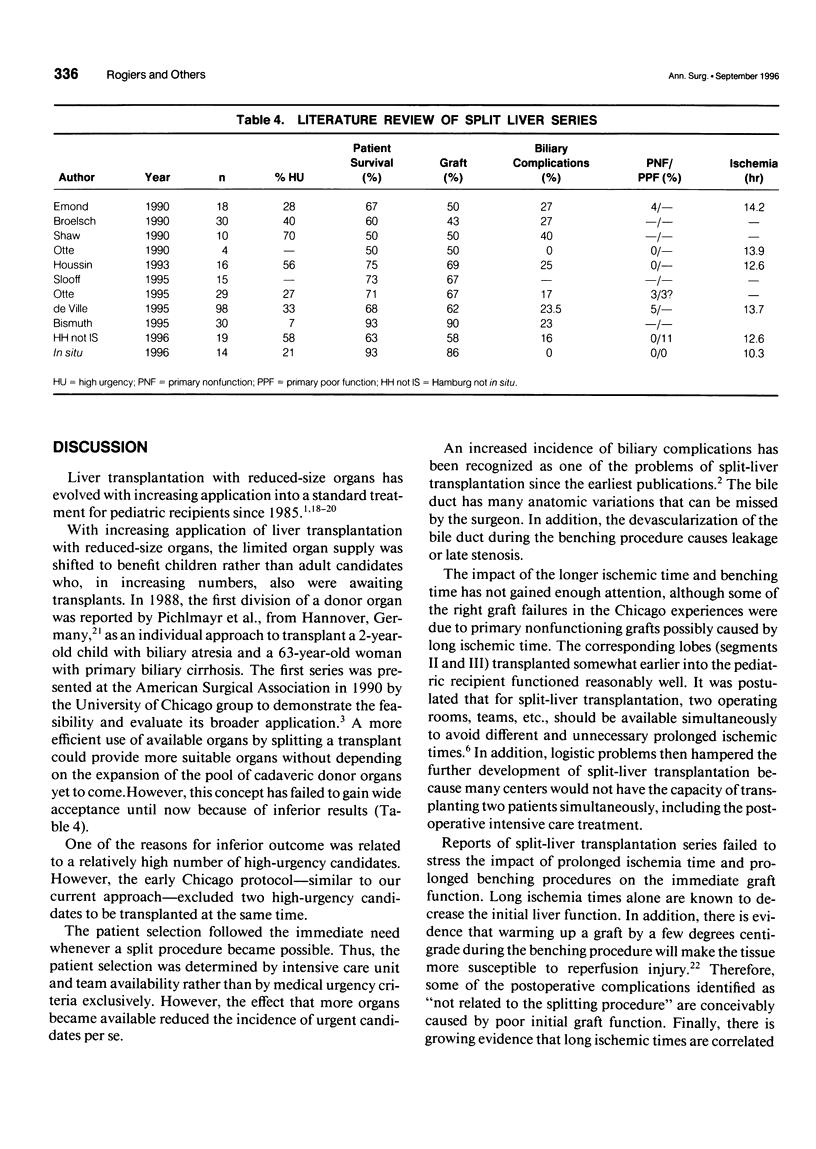

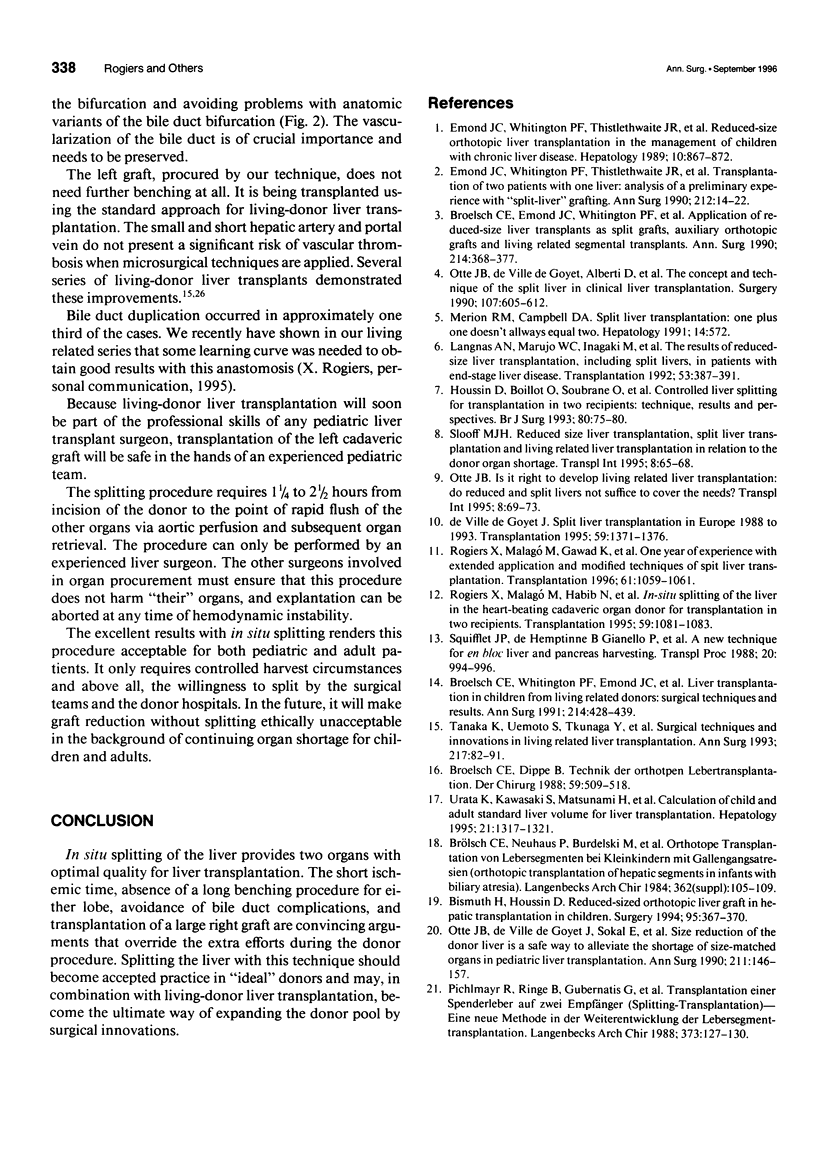
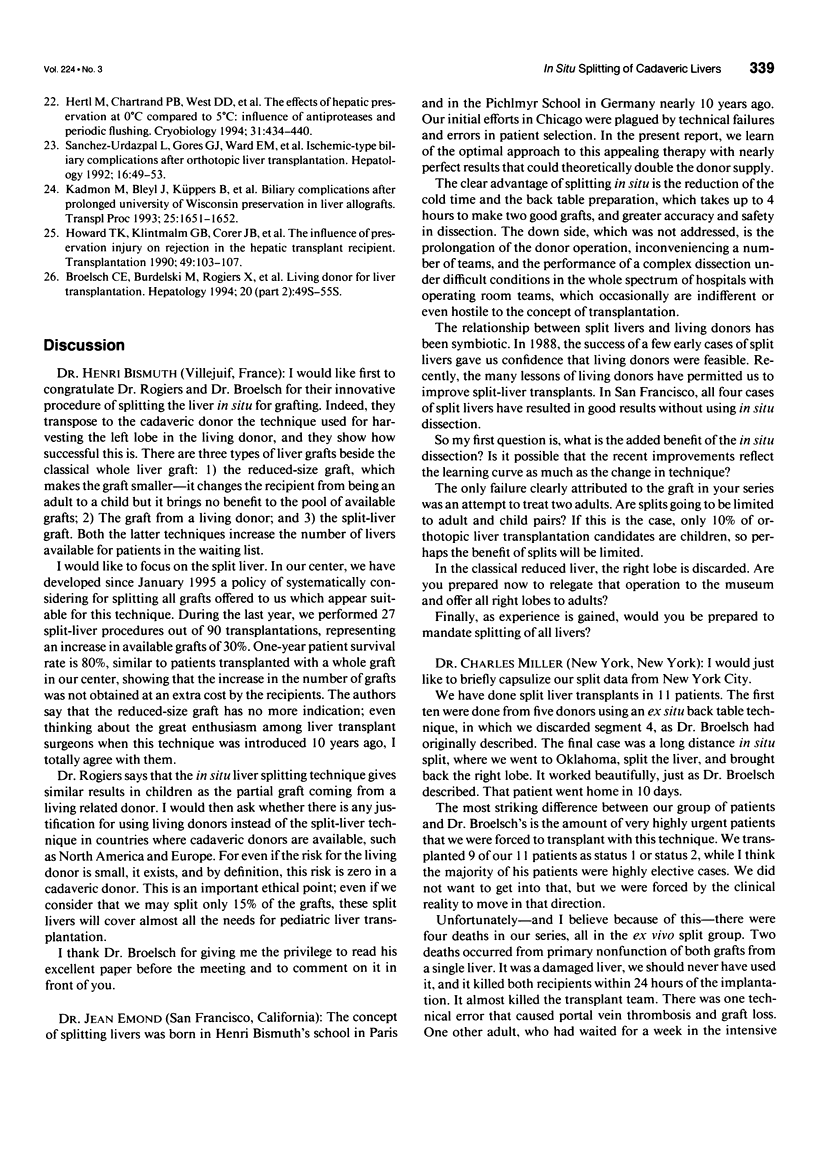
Images in this article
Selected References
These references are in PubMed. This may not be the complete list of references from this article.
- Bismuth H., Houssin D. Reduced-sized orthotopic liver graft in hepatic transplantation in children. Surgery. 1984 Mar;95(3):367–370. [PubMed] [Google Scholar]
- Broelsch C. E., Burdelski M., Rogiers X., Gundlach M., Knoefel W. T., Langwieler T., Fischer L., Latta A., Hellwege H., Schulte F. J. Living donor for liver transplantation. Hepatology. 1994 Jul;20(1 Pt 2):49S–55S. doi: 10.1016/0270-9139(94)90273-9. [DOI] [PubMed] [Google Scholar]
- Broelsch C. E., Emond J. C., Whitington P. F., Thistlethwaite J. R., Baker A. L., Lichtor J. L. Application of reduced-size liver transplants as split grafts, auxiliary orthotopic grafts, and living related segmental transplants. Ann Surg. 1990 Sep;212(3):368–377. doi: 10.1097/00000658-199009000-00015. [DOI] [PMC free article] [PubMed] [Google Scholar]
- Broelsch C. E., Whitington P. F., Emond J. C., Heffron T. G., Thistlethwaite J. R., Stevens L., Piper J., Whitington S. H., Lichtor J. L. Liver transplantation in children from living related donors. Surgical techniques and results. Ann Surg. 1991 Oct;214(4):428–439. doi: 10.1097/00000658-199110000-00007. [DOI] [PMC free article] [PubMed] [Google Scholar]
- Brölsch C., Dippe B. Technik der orthotopen Lebertransplantation. Chirurg. 1988 Aug;59(8):509–518. [PubMed] [Google Scholar]
- Emond J. C., Whitington P. F., Thistlethwaite J. R., Alonso E. M., Broelsch C. E. Reduced-size orthotopic liver transplantation: use in the management of children with chronic liver disease. Hepatology. 1989 Nov;10(5):867–872. doi: 10.1002/hep.1840100520. [DOI] [PubMed] [Google Scholar]
- Emond J. C., Whitington P. F., Thistlethwaite J. R., Cherqui D., Alonso E. A., Woodle I. S., Vogelbach P., Busse-Henry S. M., Zucker A. R., Broelsch C. E. Transplantation of two patients with one liver. Analysis of a preliminary experience with 'split-liver' grafting. Ann Surg. 1990 Jul;212(1):14–22. doi: 10.1097/00000658-199007000-00003. [DOI] [PMC free article] [PubMed] [Google Scholar]
- Hertl M., Chartrand P. B., West D. D., Harvey P. R., Strasberg S. M. The effects of hepatic preservation at 0 degrees C compared to 5 degrees C: influence of antiproteases and periodic flushing. Cryobiology. 1994 Oct;31(5):434–440. doi: 10.1006/cryo.1994.1053. [DOI] [PubMed] [Google Scholar]
- Houssin D., Boillot O., Soubrane O., Couinaud C., Pitre J., Ozier Y., Devictor D., Bernard O., Chapuis Y. Controlled liver splitting for transplantation in two recipients: technique, results and perspectives. Br J Surg. 1993 Jan;80(1):75–80. doi: 10.1002/bjs.1800800126. [DOI] [PubMed] [Google Scholar]
- Howard T. K., Klintmalm G. B., Cofer J. B., Husberg B. S., Goldstein R. M., Gonwa T. A. The influence of preservation injury on rejection in the hepatic transplant recipient. Transplantation. 1990 Jan;49(1):103–107. doi: 10.1097/00007890-199001000-00023. [DOI] [PubMed] [Google Scholar]
- Kadmon M., Bleyl J., Küppers B., Otto G., Herfarth C. Biliary complications after prolonged University of Wisconsin preservation of liver allografts. Transplant Proc. 1993 Feb;25(1 Pt 2):1651–1652. [PubMed] [Google Scholar]
- Langnas A. N., Marujo W. C., Inagaki M., Stratta R. J., Wood R. P., Shaw B. W., Jr The results of reduced-size liver transplantation, including split livers, in patients with end-stage liver disease. Transplantation. 1992 Feb;53(2):387–391. doi: 10.1097/00007890-199202010-00023. [DOI] [PubMed] [Google Scholar]
- Merion R. M., Campbell D. A., Jr Split-liver transplantation: one plus one doesn't always equal two. Hepatology. 1991 Sep;14(3):572–574. doi: 10.1002/hep.1840140327. [DOI] [PubMed] [Google Scholar]
- Otte J. B. Is it right to develop living related liver transplantation? Do reduced and split livers not suffice to cover the needs? Transpl Int. 1995;8(1):69–73. doi: 10.1007/BF00366716. [DOI] [PubMed] [Google Scholar]
- Otte J. B., de Ville de Goyet J., Alberti D., Balladur P., de Hemptinne B. The concept and technique of the split liver in clinical transplantation. Surgery. 1990 Jun;107(6):605–612. [PubMed] [Google Scholar]
- Otte J. B., de Ville de Goyet J., Sokal E., Alberti D., Moulin D., de Hemptinne B., Veyckemans F., van Obbergh L., Carlier M., Clapuyt P. Size reduction of the donor liver is a safe way to alleviate the shortage of size-matched organs in pediatric liver transplantation. Ann Surg. 1990 Feb;211(2):146–157. doi: 10.1097/00000658-199002000-00006. [DOI] [PMC free article] [PubMed] [Google Scholar]
- Pichlmayr R., Ringe B., Gubernatis G., Hauss J., Bunzendahl H. Transplantation einer Spenderleber auf zwei Empfänger (Splitting-Transplantation)--Eine neue Methode in der Weiterentwicklung der Lebersegmenttransplantation. Langenbecks Arch Chir. 1988;373(2):127–130. [PubMed] [Google Scholar]
- Rogiers X., Malago M., Habib N., Knoefel W. T., Pothmann W., Burdelski M., Meyer-Moldenhauer W. H., Broelsch C. E. In situ splitting of the liver in the heart-beating cadaveric organ donor for transplantation in two recipients. Transplantation. 1995 Apr 27;59(8):1081–1083. [PubMed] [Google Scholar]
- Rogiers X., Malagó M., Gawad K. A., Kuhlencordt R., Fröschle G., Sturm E., Sterneck M., Pothmann W., Schulte am Esch J., Burdelski M. One year of experience with extended application and modified techniques of split liver transplantation. Transplantation. 1996 Apr 15;61(7):1059–1061. doi: 10.1097/00007890-199604150-00012. [DOI] [PubMed] [Google Scholar]
- Sanchez-Urdazpal L., Gores G. J., Ward E. M., Maus T. P., Wahlstrom H. E., Moore S. B., Wiesner R. H., Krom R. A. Ischemic-type biliary complications after orthotopic liver transplantation. Hepatology. 1992 Jul;16(1):49–53. doi: 10.1002/hep.1840160110. [DOI] [PubMed] [Google Scholar]
- Slooff M. J. Reduced size liver transplantation, split liver transplantation, and living related liver transplantation in relation to the donor organ shortage. Transpl Int. 1995;8(1):65–68. doi: 10.1007/BF00366715. [DOI] [PubMed] [Google Scholar]
- Stelzner F. Die Ursache des Pilonidalsinus und der Pyodermia fistulans sinifica. Langenbecks Arch Chir. 1984;362(2):105–118. doi: 10.1007/BF01254185. [DOI] [PubMed] [Google Scholar]
- Tanaka K., Uemoto S., Tokunaga Y., Fujita S., Sano K., Nishizawa T., Sawada H., Shirahase I., Kim H. J., Yamaoka Y. Surgical techniques and innovations in living related liver transplantation. Ann Surg. 1993 Jan;217(1):82–91. doi: 10.1097/00000658-199301000-00014. [DOI] [PMC free article] [PubMed] [Google Scholar]
- Urata K., Kawasaki S., Matsunami H., Hashikura Y., Ikegami T., Ishizone S., Momose Y., Komiyama A., Makuuchi M. Calculation of child and adult standard liver volume for liver transplantation. Hepatology. 1995 May;21(5):1317–1321. [PubMed] [Google Scholar]
- de Ville de Goyet J. Split liver transplantation in Europe--1988 to 1993. Transplantation. 1995 May 27;59(10):1371–1376. doi: 10.1097/00007890-199505270-00002. [DOI] [PubMed] [Google Scholar]




